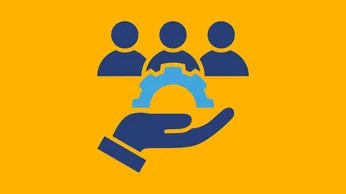On this page
For small businesses, every customer matters. But turning first-time buyers into loyal, repeat customers? That’s where the real growth happens. This is where customer loyalty programs for small businesses come into play. They’re not just about handing out discounts or freebies—they’re about creating meaningful connections that keep customers coming back.
In fact, according to Bond Brand Loyalty research, 77% of consumers are more likely to stick with a brand that offers a loyalty program. Even better, businesses see a 12–18% increase in revenue from loyalty program members compared to non-members. This shows that loyalty programs aren’t just effective—they’re profitable.
While big brands may have flashy reward schemes, small business loyalty programs can be even more impactful because of their personal, community-focused approach.
In this blog, we’ll guide you through the essentials of creating effective loyalty programs tailored for small businesses. From simple strategies to creative reward ideas, you’ll learn how to keep your customers engaged and your business thriving.
How can small businesses leverage loyalty programs to boost their customer base?
Loyalty programs aren’t just for big corporations—small businesses can also use them to build strong customer relationships, encourage repeat business, and attract new customers. Here’s how you can maximize the impact of your loyalty program to grow your customer base effectively.
1. Encourage repeat purchases
Loyalty programs create a reason for customers to return. By offering points, discounts, or exclusive perks for each purchase, customers feel rewarded for their loyalty, motivating them to choose your business over competitors. This repeated engagement builds a habit, turning occasional buyers into regular customers.
With Loyalife’s loyalty engine, small businesses can easily set up flexible point systems that fit their unique business models, making reward management seamless.
2. Turn customers into brand advocates
Happy customers are your best marketers. A referral-based loyalty program incentivizes your current customers to bring in new ones. Offering rewards like bonus points, discounts, or free products when customers refer friends helps you grow your customer base organically.
3. Personalize the customer experience
Personalization is key to customer retention. Small businesses can use loyalty programs to offer tailored rewards based on customer preferences, purchase history, or special occasions like birthdays.
Personalized offers make customers feel valued, increasing their emotional connection to your brand. Loyalife’s Engage feature helps businesses send targeted messages and personalized offers, ensuring every customer interaction feels meaningful and relevant.
4. Drive higher spending
Loyalty programs motivate customers to spend more. By setting milestones like “spend $100 to earn a bonus reward,” customers are encouraged to increase their purchase value to reach these goals.
Tier-based loyalty programs, where customers unlock better rewards as they spend more, can further boost spending habits. This strategy not only increases revenue but also strengthens customer loyalty.
5. Collect valuable customer data
Loyalty programs aren’t just about rewards—they’re also powerful tools for gathering customer insights. By tracking purchase history, preferences, and engagement patterns, small businesses can make data-driven decisions to improve products, services, and marketing strategies.
Understanding your customers better helps you deliver exactly what they want, fostering loyalty and encouraging repeat business.
6. Create a sense of exclusivity
Everyone loves feeling special. Offering VIP tiers, early access to new products, birthday rewards, or members-only events makes customers feel appreciated and part of an exclusive community. This sense of exclusivity deepens the emotional connection to your brand, making customers more likely to stay loyal and recommend your business to others.
7. Boost engagement through gamification
Gamifying your loyalty program keeps it fun and engaging. Adding challenges, progress bars, achievement badges, or limited-time bonus events encourages customers to participate more actively. This playful approach increases interaction with your brand, fosters healthy competition among customers, and keeps them coming back for more.
8. Strengthen customer relationships with consistent communication
Loyalty programs provide a platform to maintain regular communication with your customers. Sending personalized emails, updates about their reward status, exclusive offers, and friendly reminders keeps your business top-of-mind.
Using Loyalife’s customer engagement tools, you can automate and personalize these communications, ensuring your messages resonate with your audience and drive continued engagement.
The role of personalization in customer loyalty programs for small businesses
Personalization is the secret ingredient that transforms an ordinary loyalty program into an extraordinary one. For small businesses, it’s not just a nice-to-have feature—it’s a powerful way to build deeper connections with customers. Unlike big corporations, small businesses have the advantage of knowing their customers on a more personal level, and this can be leveraged to create meaningful loyalty experiences.
Why personalization matters:
Generic rewards may work for some, but personalized offers create a sense of exclusivity and make customers feel valued. When customers receive rewards that align with their interests, purchase habits, or special occasions like birthdays, it strengthens their emotional connection to your brand, increasing the chances of repeat business.
How to personalize your loyalty program:
- Use customer data: Analyze purchase history, preferences, and behavior to offer relevant rewards.
- Tailor promotions: Send personalized emails with special offers based on what your customers love.
- Celebrate milestones: Recognize birthdays, anniversaries, or loyalty milestones with exclusive rewards.
- Segment your audience: Group customers based on their activity and interests to deliver targeted campaigns.
Leverage Loyalife for personalized loyalty experiences
With Loyalife Engage, small businesses can automate personalized messages, offers, and campaigns based on customer data. This ensures that every interaction feels relevant and meaningful, helping you retain loyal customers and drive long-term engagement.
Personalization isn’t just a strategy—it’s the key to making your customers feel seen, heard, and appreciated. And that’s what keeps them coming back.
5 Customer loyalty programs for small business
Implementing the right loyalty program can help small businesses boost customer retention, encourage repeat purchases, and drive growth. Here are five customer loyalty programs for small businesses that are easy to set up, cost-effective, and proven to keep customers coming back.
1. Punch cards or stamp cards
For small businesses, punch cards or stamp cards are among the easiest and most effective loyalty programs. With this conventional approach, clients receive a physical card that needs to be punched or stamped each time they make a transaction. Once the card is filled, the customer receives a reward, such as a free item or a discount on their next purchase.
How it works:
- Customer engagement: A punch or stamp is applied to a customer's card each time they make a valid purchase. For example, For each cup of coffee purchased a coffee shop could provide a stamp.
- Reward system: The customer receives a reward after a predetermined amount of punches or stamps. Usually, the incentive is anything that makes the consumer want to keep coming back to the company, such as a free coffee after ten transactions or a coupon on their next visit.
- Simplicity and cost-effectiveness: Punch cards offer simplicity and cost-effectiveness due to their low implementation costs and minimal investment requirements. To strengthen brand identity, they can be created using the colors and logo of your company.
This simple strategy not only encourages clients to return, but it also acts as a physical reminder of your business, giving them a sense of satisfaction as they work towards their reward.
2. Points-based programs
Points-based loyalty programs are a well-liked and adaptable choice for small companies trying to reward loyal clients. Customers who participate in this kind of program accrue points for each purchase they make, which can then be exchanged for incentives, savings, or other benefits.
How it works:
- Earning points: Points are earned by customers based on their spending volume. For each dollar spent, for instance, a consumer might receive one point. This method is adaptable to various business strategies and consumer spending habits.
- Redeeming points: Customers can swap their points for a variety of rewards once they have accumulated a certain number. These incentives may take the form of free merchandise, exclusive services, or discounts on subsequent purchases. For example, a clothes store might give out a free item upon reaching a particular point barrier or offer a $10 discount for every 100 points accrued.
Panera Bread's MyPanera is a great example of a point-based loyalty program for small businesses. It's an American fast-casual restaurant chain. Customers can earn points through the program for each purchase they make. Points can be exchanged for a number of benefits, such as free baked goods, menu item reductions, and exclusive member-only deals. With customized rewards, this program not only promotes return business but also improves the typical customer experience.
3. Tiered programs
Customers who participate in tiered loyalty programs may obtain increasingly better incentives as they advance through the levels, which are determined by their spending and level of engagement with the business. In addition to rewarding loyal customers, this strategy encourages them to spend more to move up to higher tiers and earn additional benefits.
How it works:
- Levels and benefits: Consumers begin at the lowest tier and may move up to different tiers- e.g. Silver, Gold, and Platinum by earning points, completing transactions, or interacting with the brand. With every tier, members can look forward to ever-more exciting perks like free shipping, early bird prices on new products, invites to special events, and larger savings.
- Encouraging customer engagement: By offering higher rewards at higher stages, businesses encourage customers to keep shopping and connecting with them. Because clients are encouraged to go to the next level to gain higher benefits, the tiered structure fosters a sense of exclusivity and desire.
Tiered loyalty programs are a great way for small businesses to develop a loyal clientele. A tiered loyalty program provided by Sweetgreen, a fast-casual salad restaurant company, promotes repeat business and increased expenditure. Consumers can move up from the green tier to the gold and black tiers by increasing their expenditure and frequency of visits. Higher point multipliers, access to secret menu items, and invites to special events are just a few of the extra unique advantages that black members, the top tier, enjoy.
4. Subscription-based programs
Customers who participate in subscription-based loyalty programs pay a regular charge, usually once a month or yearly, in exchange for special advantages. Through consistent interaction, this model offers clients ongoing value and guarantees a consistent flow of recurring money for the company, strengthening customer loyalty.
How it works:
- Exclusive benefits: Members-only products and events, early access to new products and services, discounts, and free goods and services are just a few benefits subscribers enjoy. The key is to provide advantages that are strong enough to support the cost of the membership.
- Recurring revenue: Businesses can generate a steady stream of income by implementing a membership charge. Due to this financial stability, small businesses can invest in better services, better goods, and more effective consumer engagement initiatives.
Companies may enhance their customer base, boost retention, and foster sustainable expansion by offering continuous value and special benefits. The online bookstore Bookshop.org, which helps out small, independently owned bookshops in the community, has a subscription-based loyalty programme called "Friends Membership." Members enjoy free shipping on all orders, early access to new book releases, special promotions, and exclusive access to author events for an annual fee.
5. Digital loyalty apps
Digital loyalty applications use technology to improve user experience and make managing loyalty programs easier. With the help of these applications, companies can track consumer behavior, give out prizes, and collect insightful data that will help them better engage customers and tailor their marketing.
How it works:
- Reward tracking: With every transaction, customers can utilize the loyalty app to accrue points or prizes. Punch cards or stamps are no longer necessary because the app automatically tracks their activities and progress towards prizes.
- Personalization: Businesses can collect information about consumer preferences, past purchases, and behavior through digital loyalty apps. By customizing prizes, incentives, and marketing messages for specific consumers, this data can raise the relevance and effectiveness of these efforts.
- Convenience: Consumers value the ease of use provided by digital loyalty programs, which let them monitor their points, get access to special deals, and shop from their smartphones. Repeat business and continuing engagement are encouraged by this flawless experience.
Small businesses can develop dynamic, data-driven loyalty programs that increase customer engagement, retention, and revenue with the help of digital loyalty applications. Businesses may improve client interactions and maintain their competitiveness in today's digital economy by utilizing technology.
Loyalife: The perfect loyalty solution for small businesses
When it comes to running an effective customer loyalty program for small businesses, Loyalife offers the perfect blend of simplicity, flexibility, and impact. It’s a comprehensive Loyalty Business Management System (LBMS) designed to help small businesses create, manage, and grow loyalty programs that truly engage customers.
1. Customizable loyalty engine
Loyalife’s Loyalty engine allows small businesses to design tailored programs—whether it’s points-based, tiered rewards, or referral bonuses. You can set up earning rules, create VIP tiers, and personalize rewards to fit your business goals.
2. Personalized engagement with Loyalife Engage
With Loyalife Engage, businesses can send targeted offers and personalized messages based on customer behavior. From birthday discounts to exclusive promotions, it helps you connect meaningfully with your audience.
3. Diverse rewards marketplace
Loyalife offers access to a vast rewards marketplace with over 10 million options, including gift cards, merchandise, and travel experiences. This keeps your program exciting and customers eager to participate.
4. Data-driven insights with custom measurement
Loyalife’s custom measurement feature tracks customer behavior and program performance, providing actionable insights to optimize your loyalty strategies.
5. Affordable and scalable
Designed for small businesses, Loyalife is affordable and scalable, allowing you to start simple and expand as your business grows.
With Loyalife, small businesses can easily create loyalty programs that boost customer retention, drive repeat purchases, and foster lasting relationships.
Ready to grow your small business with Loaylife? Get started today!
Conclusion
Choosing the right loyalty program for small business is crucial. It's important to build enduring relationships rather than focusing only on rewards. Recognise your audience's preferences, modify your program to suit their needs, and enjoy higher levels of engagement and retention. Thinking of long-term success, your loyalty program can become a valuable strategic tool.
FAQs
1.How can a customer loyalty program benefit my small business?
A loyalty program encourages repeat purchases, increases customer retention, and helps build stronger relationships with your customers, ultimately boosting revenue.
2.What type of loyalty program works best for small businesses?
Points-based, tiered rewards, referral programs, and punch card systems are popular for small businesses due to their simplicity and effectiveness.
3.Is it expensive to set up a loyalty program for a small business?
Not necessarily. Platforms like Loyalife offer affordable solutions that can be tailored to fit your budget and business size.
4.How do I know if my loyalty program is working?
Track key metrics like customer retention rates, repeat purchases, average order value, and engagement levels to measure success.
5.Can I run a loyalty program without using complicated software?
Yes, but using platforms like Loyalife's Loyalty Engine simplifies management, allowing you to create, track, and optimize your program effortlessly.
6.What kind of rewards should I offer in my loyalty program?
Offer rewards that your customers value, such as discounts, free products, exclusive experiences, or points redeemable through platforms like Xoxoday Rewards Marketplace.
7.How do I keep customers engaged in my loyalty program?
Regularly update rewards, personalize offers, introduce gamification elements, and maintain clear communication using tools like Loyalife Loyalife Engage.
8.Is a loyalty program suitable for both online and brick-and-mortar small businesses?
Absolutely! Loyalty programs can be customized for in-store, online, or hybrid businesses to fit your customer’s shopping habits.
9.How can I personalize my loyalty program for different customers?
Use customer data to segment audiences and create personalized rewards and offers. Loyalife analytics tools help track behavior and tailor campaigns effectively.
10.Do loyalty programs really help with customer acquisition?
Yes, especially when combined with referral incentives. Loyal customers can become brand advocates, bringing in new customers through word-of-mouth and referrals.















